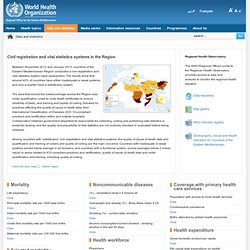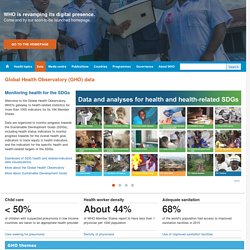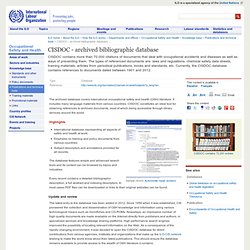

World bank Health Nutrition and Population Statistics. WHO Western pacific. WHO Europe data. European Observatory on Health Systems and Policies. European Observatory on Health Systems and Policies The Observatory supports and promotes evidence-based health policy-making through comprehensive and rigorous analysis of the dynamics of health care systems in Europe.

Read more Top story Rethinking health at the 74th United Nations General Assembly25-04-2019 A recent side event at the 74th session of the United Nations General Assembly, co-hosted by the European Observatory on Health Systems and Policies and WHO, has demonstrated how health expenditure drives sustainable and inclusive growth rather than being a drain on the economy. Read more Health system reviews (HiTs) Countries’ health system reviews with facts, figures and trends Full list of HiTs Policy briefs and summaries Brief reports outlining available evidence or experience on a specific policy question or area and drawing key policy options and lessons from it Full list of policy briefs and summaries Country Health Profiles Go to the Country Health Profiles page Eurohealth.
WHO Eastern Mediterranean health observatory. Civil registration and vital statistics systems in the Region Between November 2012 and January 2013, countries of the Eastern Mediterranean Region conducted a civil registration and vital statistics system rapid assessment.

The results show that around 40% of countries have either inadequate or weak systems, and only a quarter have a satisfactory system. The area that scored the lowest average across the Region was coder qualification (used to code death certificates to ensure reliability of data), and training and quality of coding, followed by practices affecting the quality of cause of death data, then International Classification of Diseases (ICD 10)-compliant practices and certification within and outside hospitals. Collaboration between government departments responsible for collecting, coding and publishing vital statistics is evidently lacking, and the quality and plausibility of vital statistics are not routinely checked or evaluated before being released.
WHO SEAR (South east Asia) PAHO Regional Health Observatory (Latin America) World Health Organization. Global Strategy for Women's, Children's and Adolescents' Health (2016-2030): Data portal The Every Woman Every Child Global Strategy indicator and monitoring framework includes 60 indicators from health and other sectors. 34 indicators are from the Sustainable Development Goals (SDGs) and 26 from related global monitoring initiatives.

From these, 16 key indicators are highlighted to provide a snapshot of progress. The Global Strategy portal provides open access to the latest available data and estimates for the 60 indicators across 194 countries. This involves collaboration across WHO departments, H6 agencies (UNAIDS, UNFPA, UNICEF, UN Women, WHO and the World Bank), other UN organizations - including the UN Statistics Division and UNESCO, and global monitoring partnerships, including the Countdown to 2030 and academic institutions. – Access the portal Global Observatory on Health Research and Development (R&D) – Access the Observatory fact buffet Child care Care seeking for pneumonia. Maternal Mortality Information. Child Mortality Estimates. WHO bibliographic Databases. World Health Statistics. World Health Report. Global Health Observatory Data Repository(WHO) AIDSinfo (United Nations)
OECD iLibrary healthstats. CISDOC - bibliographic database (ILO Occupational health) The archived database covers international occupational safety and health (OSH) literature.

It includes many language materials from various countries. CISDOC constitutes an ideal tool for obtaining references to archived documents, most of which being accessible through library services around the world. International database representing all aspects of safety and health at work; Emphasis on training and policy documents from various countries; Subject descriptors and annotations provided for all records. The database features simple and advanced search tools and its content can be browsed by topics and industries. Every record contains a detailed bibliographic description, a full abstract and indexing descriptors. Update and review The latest entry to the database has been added in 2012. Legislation Archived legislative texts and bibliographic information on past OSH laws, regulations and directives are also available in CISDOC via browsing by countries and subject categories.